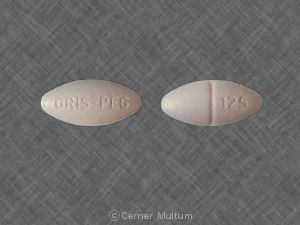What is Gris-PEG (Griseofulvin)?
Griseofulvin is an antifungal medication. It is like an antibiotic but is used to treat fungal infections.
Griseofulvin is used to treat fungal infections of the skin, hair, and nails such as jock itch, athlete’s foot, and barber’s itch.
Griseofulvin may also be used for purposes other than those listed in this medication guide.
What is the most important information I should know about Gris-PEG (Griseofulvin)?
Take all of the griseofulvin that has been prescribed for you even if you begin to feel better. Your symptoms may begin to improve before the infection is completely treated.
Avoid prolonged exposure to sunlight. Griseofulvin increases sensitivity to sunlight, and severe burning may result.
What should I discuss with my healthcare provider before taking Gris-PEG (Griseofulvin)?
You cannot take griseofulvin if you
- have ever had an allergic reaction to it,
- have porphyria, or
- have liver disease
Talk to your doctor before taking griseofulvin if you have any of the conditions listed above.
Griseofulvin is in the FDA pregnancy category C. This means that it is not known whether griseofulvin will harm an unborn baby. In rare cases, the use of griseofulvin has been associated with conjoined twins. Do not take this medication without first talking to your doctor if you are pregnant.
It is also not known whether griseofulvin passes into breast milk. Do not take this medication without first talking to your doctor if you are breast-feeding a baby.
Griseofulvin may affect sperm and sperm production. It is recommended that you avoid fathering a child during treatment with griseofulvin and for 6 months following therapy.
Gris-PEG Side Effects
What are the possible side effects of Gris-PEG (Griseofulvin)?
Stop taking griseofulvin and seek emergency medical attention if you experience an allergic reaction (difficulty breathing; closing of your throat; swelling of your lips, tongue, or face; or hives).
Other, less serious side effects may be more likely to occur. Continue to take griseofulvin and notify your doctor if you experience
- white patches in your mouth (thrush/yeast infection)
- nausea, vomiting, or diarrhea
- headache, dizziness, or tiredness
- insomnia
- confusion
- numbness or tingling in your hands or feet; or
- menstrual irregularities
This is not a complete list of side effects and others may occur. Call your doctor for medical advice about side effects. You may report side effects to FDA at 1-800-FDA-1088. You may report side effects to FDA at 1-800-FDA-1088.
Gris-PEG Interactions
What other drugs affect Gris-PEG (Griseofulvin)?
Griseofulvin may decrease the effects of the following drugs:
- oral anticoagulants (blood thinners) such as warfarin (Coumadin). A decrease in the effectiveness of anticoagulants could lead to blood clotting. It may be necessary to increase anticoagulant dosage
- birth control pills. Decreased effectiveness could lead to break-through bleeding and possibly to an unintended pregnancy. Talk to your doctor about using of other forms of birth control during treatment with griseofulvin
- salicylates such as aspirin, salsalate (Disalcid, Salsitab, Salflex, others), choline salicylate (Arthropan), magnesium salicylate (Doan’s, Magan), and others. Larger doses of these medicines may be needed
- cyclosporine (Sandimmune, Neoral). Your doctor may need to adjust your cyclosporine dosage
The effects of griseofulvin may be decreased by barbiturates such as phenobarbital (Luminal, Solfoton), pentobarbital (Nembutal), secobarbital (Seconal), amobarbital (Amytal), and butabarbital (Butisol). Larger doses of griseofulvin may be necessary if you are taking any of these drugs.
Drugs other than those listed here may also interact with griseofulvin. Talk to your doctor and pharmacist before taking any prescription or over-the-counter medicines.
What should I avoid while taking Gris-PEG (Griseofulvin)?
Avoid prolonged exposure to sunlight. Griseofulvin increases sensitivity to sunlight, and severe burning may result. Use a sunscreen and wear protective clothing when exposure to the sun is unavoidable.
The combination of alcohol and griseofulvin may cause flushing and a fast heart rate. Use alcohol cautiously during treatment with griseofulvin.
Gris-PEG Dosage
How should I take Gris-PEG (Griseofulvin)?
Take griseofulvin exactly as directed by your doctor. If you do not understand these instructions, ask your pharmacist, nurse, or doctor to explain them to you.
Take each dose with a full glass (8 ounces) of water.
Your doctor may recommend that you take griseofulvin with a fatty meal to increase its absorption into your body.
Take all of the griseofulvin that has been prescribed for you even if you begin to feel better. Your symptoms may begin to improve before the infection is completely treated.
Shake the suspension well before measuring a dose. To ensure that you get a correct dose, measure the liquid form of griseofulvin with a dose-measuring spoon or cup, not with a regular tablespoon. If you do not have a dose-measuring device, ask your pharmacist where you can get one.
Store griseofulvin tablets, capsules, and suspension at room temperature away from moisture and heat.
What happens if I overdose on Gris-PEG (Griseofulvin)?
Seek emergency medical attention.
Symptoms of a griseofulvin overdose are not well known but might include nausea, vomiting, diarrhea, headache, numbness and tingling, and confusion.
What happens if I miss a dose of Gris-PEG (Griseofulvin)?
Take the missed dose as soon as you remember. Take the rest of the day’s doses at evenly spaced intervals unless your doctor directs otherwise.
Sourced from everydayhealth.com

